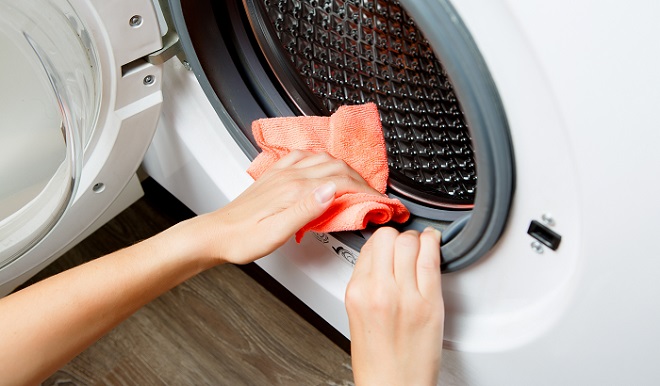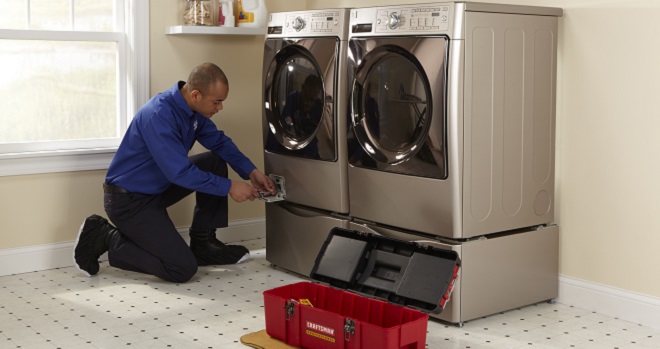How Does a Front Load Washer Work?

Front-loading washers are increasingly popular due to their efficiency and performance. This article provides an in-depth look at how a front load washer works, including key components like the fill valve assembly and dispenser drawer.
KEY TAKEAWAYS
- Front load washers use a horizontal tub with a stainless steel spin basket inside that tumbles clothes through a limited amount of water in the tub to gently clean garments.
- Sensors and the electronic control board fill the washer with the right amount of water and control the components to efficiently clean the clothes.
- Cleaning and maintaining the front load washer is essential to prevent odors and keep the washer working efficiently.
Overview of Front Load Washers
Front-loading washers are known for their efficient cleaning capabilities. Unlike top-load washers, these machines have a horizontal drum that rotates to agitate and clean clothes. This design offers numerous benefits, such as better water usage and gentler handling of fabrics.
The main components of a front load washer include:
- Wash tub: The large, horizontal plastic tub suspended in the washer cabinet by springs and shocks.
- Spin basket: Stainless steel cylinder inside the wash tub that holds the clothes.
- Drive motor: Connect to the spin basket directly or with a drive belt, this motor rotates the spin basket to tumble and spin out the clothes during the wash cycle.
- Fill valve assembly: Electrically operated water valves that fill the washer with water during the wash cycle.
- Dispenser drawer: Holds detergent, bleach and fabric softener. Dispenses the additives into the wash tub at the right time during the wash cycle.
- Drain pump: Drains water from the washer during the cycle.
- Control panel: Allows you to start and stop the wash cycle and select cycle settings.
The washing process in a front load washer relies heavily on drum rotation and water flow. The drum tumbles the clothes, lifting and dropping them repeatedly to ensure thorough cleaning. This tumbling motion, combined with efficient water usage, helps detergent penetrate every fiber of the fabric, resulting in cleaner clothes with less wear and tear.
Front load washers use less water than top load washers thanks to their unique design. The spin basket uses strategically placed baffles (or paddles) to tumble and immerse the clothes in a small amount of water at the bottom of the wash tub during the wash cycle. This not only conserves water but also enhances cleaning performance.

Fill Cycle
The fill cycle in a front load washer is crucial for preparing the machine for the washing process. Water enters the washer through an inlet valve at the back of the machine. When the fill cycle is selected, the valve opens to allow water into the drum. The amount of water varies based on load size and selected water level options. A sensing system determines the size of load and fills the tub with the right amount of water.
Front load washers offer different water temperature settings to accommodate various fabrics and load sizes. You can choose hot, warm, or cold water options. Temperature sensors detect fill water temperature and control the hot and cold water fill valves to fill the wash tub with water at the selected temperature.
Dispenser Drawer
The dispenser drawer is a vital component of a front load washer, allowing you to add detergent, fabric softener, and bleach to tub at the right time during laundry cycles. Understanding how a washing machine works, including how to use the different compartments in the dispenser drawer, is essential for achieving clean and fresh-smelling clothes.
Dispenser Drawer Components
The dispenser drawer typically includes three compartments:
- Detergent compartment: This compartment holds laundry detergent – powder or liquid.
- Fabric softener compartment: Used for adding fabric softener or other laundry additives.
- Bleach compartment: This compartment is for adding bleach and is labeled accordingly.
A control system on the dispenser drawer housing routes water through the compartments at the right time during the cycle to dispense the detergent and additives.
How to Use the Dispenser
To use the dispenser drawer correctly, follow these steps:
- Refer to the washer's user manual to identify the specific compartments and how to use them. You’ll often need to remove an insert from the detergent compartment when using powdered detergent.
- Pour the recommended amount of detergent into the detergent compartment, avoiding overfilling. Because a front load washer uses less water, you’ll typically only need about a tablespoon of HE detergent for most laundry loads.
- Add fabric softener to the fabric softener compartment, following the product label instructions. Some front load washers recommend diluting fabric softener with water so it flows into the tub freely during the cycle.
- If using bleach, pour the appropriate amount into the bleach compartment. On many front load washers, not all cycles dispense bleach. Check your owner’s manuals for details about which cycles dispense bleach in your model.
- Close the dispenser drawer and start the desired laundry cycle.
Cleaning and Maintaining the Dispenser Drawer
Regular cleaning and maintenance of the dispenser drawer are important to prevent the buildup of detergent or fabric softener residue. Here are some tips to keep it in optimal condition:
- Remove the dispenser drawer and rinse it with warm water to remove any residue.
- Use a mild detergent and a soft brush to clean the compartments thoroughly.
- Allow the dispenser drawer to dry completely before reinserting it into the washer.
- Inspect the dispenser drawer regularly for signs of damage or blockage and replace if necessary.
Wash Cycle
After filling, the drive system kicks in and tumbles the clothes. The electronic control board in the washer determines the speed and direction of tumbling action to clean the clothes effectively based on load size and cycle selection.
After tumbling to clean the clothes, the dirty water is drained from the tub by the drain pump.
The fill valves refill the tub for the rinse cycle and fabric softener is dispensed in the rinse water. The drive system again kicks in and tumbles the load to rinse detergent from the clothes.
After rinsing, the drain pump empties the wash tub and the drive system spins the basket at high speeds to sling water out of the clothes. After spinning, the cycle ends.
Front Load Washer Maintenance
Regular cleaning will help keep your front load washing machine smelling fresh and working properly. Follow the expert tips shown in this video to keep your front load washer clean and working properly.
Use a washing machine cleaner such as Affresh to clean the washer tub monthly. You may need to clean the washer more often if smells develop.

Wiping down the rubber door boot with a bleach and water solution every month is essential to preventing odors. Mold and mildew can develop quickly in the folds of the door boot. Bleach will kill mold and mildew and help prevent new growth between cleanings.
If your washer has a drain pump filter access door on the bottom left side of its front panel, clean the drain pump filter at least every 6 months. The diagram below shows how to clean the drain pump filter in many front load washers.

Items such as coins and paper clips can wind up in the drain pump filter. You may also find hair and lint in the filter. If you smell an awful odor when you pull out the drain pump large item filter, follow these steps to get rid of the smell:
- Clean the filter and its housing with a bleach and water solution.
- Run an empty Bulky wash cycle using hot water with a cup of chlorine bleach added.
- Run an empty cycle with no detergent or additives to rinse all bleach out of the washer.
- Cut back on the amount of detergent and additives that you’re using to prevent the awful smell from returning.
- Clean the drain pump large item filter more often and check for continued odor problems.
If you see damage to the drain pump when cleaning the filter and housing, schedule washer repair service and we’ll send a technician to your home to fix the problem.

Schedule Annual Maintenance by a Service Technician
Have a service professional clean and maintain your front load washer yearly to help prevent odors and breakdowns. The technician will examine and adjust all parts of the washer to help keep it in top condition and minimize wear. The tech will also replace any worn components before they break completely so you won’t be stuck without a washer and waiting for washer repair due to an unexpected part failure. Schedule annual washer maintenance and cleaning through Sears Home Services to help keep your washing machine in top shape and lasting longer.
By understanding how a front load washer works and how to maintain it, you can ensure that your machine operates efficiently and delivers clean, fresh laundry every time.
Schedule washer maintenance now!
Increase the lifespan and performance of your washer with our comprehensive maintenance service, ensuring reliable laundry care and continued peace of mind.
Was this information helpful?
Schedule washer maintenance now!
Maintain Washer Resources
Learn how a high-efficiency washer works and how to maintain it effectively.
Learn how portable washing machines work and how to use and maintain them properly.
Learn how the fabric softener dispenser works and how to keep it working right.
Learn how a washer works and how to keep it working efficiently.
Glossary Terms
Hard water is water that contains high levels of dissolved minerals, particularly calcium and magnesium. It contrasts with soft water, which has lower concentrations of these minerals.
A washing machine pedestal is a platform that raises the washer off the ground, providing easier access to the appliances and often includes additional storage space such as drawers.
A washer tub is the interior part of a washing machine where clothes are placed for washing, typically made of stainless steel, plastic, or porcelain-coated metal, designed to hold water and withstand the agitation or spinning during the wash cycle.
Fabric softener is a laundry additive used to soften and freshen clothing, reduce static cling, and make fabrics feel smoother.
Common Repair Washer Symptoms
The most common reasons your Whirlpool washer won't stop filling are a clogged water valve, a bad water-level pressure switch, or a malfunctioning electronic control board.
The most common reasons your Whirlpool washer won't spin or drain are a seized gearcase, a broken motor, or a failed door switch.
The most common reasons your Whirlpool washer won't turn off are a malfunctioning electronic control board, broken motor or a jammed door lock assembly.
The most common reasons your Whirlpool washer won't start cycle are a malfunctioning electronic control board, jammed door lock assembly or a faulty user interface.
The most common reasons your Whirlpool washer vibrates are a damaged suspension rod, malfunctioning electronic control board or a dead fan.
The most common reasons your Whirlpool washer is experiencing the rinse cycle not working are a broken lid switch, a bad water-level pressure switch, or a malfunctioning electronic control board.



